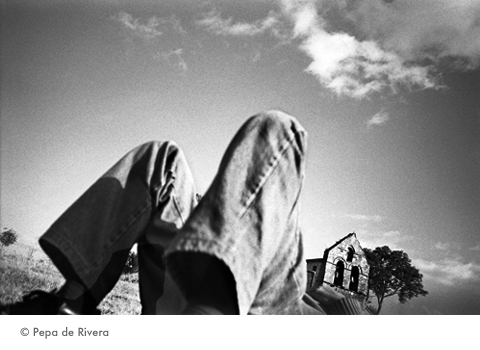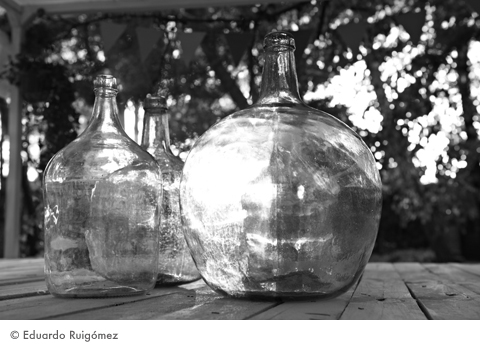Photographic eidetic space as a distortion of reality
© Eduardo Ruigómez
Ignoring the separation between subject and object, the artist didn´t face nature to explore it through geometry, but became part of the cosmos just like a tree, water and a stone; he was the meeting point of the four elements and it never occurred to him that he was a creator, an exceptional and inspired creature.
(Zbiegniew Herbert: The labyrinth next to the sea. Translated byAnna Rubió and Jerzy Slawomirski)
Technological development in the digital era has taken giant steps in general access to the practice and versatility in the use of photography. The digital camera, either professional, portable editions or those attached to cell phones, allow us to capture instantaneous images anywhere and at all times. And we can share them universally with the same agility through the different tools of internet.
 This may be a truism, but I´m interested in recreating the magic instant when we feel the desire to take a picture. I suspect it has changed too much with the intrusion of the latest technologies. One century after Kodak´s 1888 publicity slogan ("You press the button, we do the rest"), something perverse seems to have slipped in through imitation. The ability to take indefinite instant photographs annuls the intellectual exercise of thinking about what we want to register. The false abundance of images increases the probabilities of obtaining results. In a world of haste and tight agendas we need to run twice as much to get somewhere, just like Alice in Lewis Carroll´s tales.
This may be a truism, but I´m interested in recreating the magic instant when we feel the desire to take a picture. I suspect it has changed too much with the intrusion of the latest technologies. One century after Kodak´s 1888 publicity slogan ("You press the button, we do the rest"), something perverse seems to have slipped in through imitation. The ability to take indefinite instant photographs annuls the intellectual exercise of thinking about what we want to register. The false abundance of images increases the probabilities of obtaining results. In a world of haste and tight agendas we need to run twice as much to get somewhere, just like Alice in Lewis Carroll´s tales.
Evegny Morozov warns us of the risks of technology as a substitute for our tasks: with greater technological efficiency, our brains need to perform less intellectually: a perverse mechanism that makes the extremely high productivity of machines feed laziness in our intellectual activity. The logical solution proposed by the author is surprising: not to do anything as something "necessary to develop our mental faculties."
Let us return to the photographic session. Seen from outside, we find ourselves with three elements that intervene in the act of making a photograph: the subject, object and space. All three elements are necessary to capture an image. The subject leads the action: he composes the scene, centers the object, frames the image, adjusts speed and diaphragm, focuses and shoots. Meanwhile, the object rests obediently, awaits the sound of the shooting that indicates the photography has materialized. Along this sequence, the third element, space, has remained impassible in its position, as a silent, insignificant witness.
 I am especially interested in the role of space, that redundant character, the nothing that "is in every way as material as something, especially when defined as the absence of something" (Lawrence M. Krauss). Space envelops the encounter between the photographer and the object. Without space, subject and object cannot find each other. The photographer acts as the issuer, the object is the receptor, and the function of connectivity is left to space.
I am especially interested in the role of space, that redundant character, the nothing that "is in every way as material as something, especially when defined as the absence of something" (Lawrence M. Krauss). Space envelops the encounter between the photographer and the object. Without space, subject and object cannot find each other. The photographer acts as the issuer, the object is the receptor, and the function of connectivity is left to space.
Space represents a protective shield that shelters the development of action. When the subject locates the scene, he does it with the spirit of one who makes it his own; his view of the scene defines the framing. Once the space is defined, the object takes on its protagonist role: it pushes the interest of the space out of the frame and captures the attention of all looks from then on.
Space is never in a hurry, has all infinite time on its side and behaves in a stable manner. It lives quietly in its galactic space, while naughty subjects and objects orbit crazily through its deserted entrails, suffering under the distortions of reality. As in any film by Tarkovski, that which is unseen transcends, visual perceptions are our footprints that survive.
At a subsequent phase, a new voyeur subject emerges, that can only see the final product mutilated in its full significance, with no real space; like a soul that on leaving the body, only leaves behind a halo full of vibrating echoes that stimulate emotions and fantasies.


